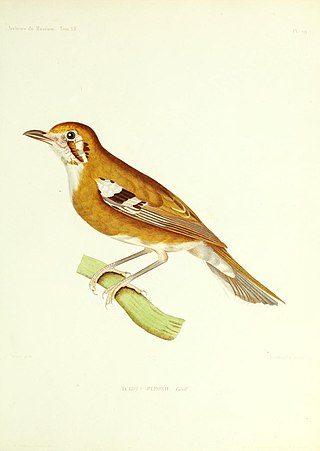
Crowdy Bay is a national park in New South Wales, Australia, 271 km northeast of Sydney.

Carlia is a genus of skinks, commonly known as four-fingered skinks or rainbow skinks, in the subfamily Eugongylinae. Before being placed in this new subfamily, Carlia was recovered in a clade with the genera Niveoscincus, Lampropholis, and others of the Eugongylus group within Lygosominae.

The southern right whale dolphin is a small and slender species of cetacean, found in cool waters of the Southern Hemisphere. It is one of two species of right whale dolphin. This genus is characterized by the lack of a dorsal fin. The other species, the northern right whale dolphin, is found in deep oceans of the Northern Hemisphere and has a different pigmentation pattern than the southern right whale dolphin.

François Auguste Péron was a French naturalist and explorer.

Thenus orientalis is a species of slipper lobster from the Indian and Pacific oceans.

Ibacus peronii, the Balmain bug or butterfly fan lobster, is a species of slipper lobster. It lives in shallow waters around Australia and is the subject of small-scale fishery. It is a flattened, reddish brown animal, up to 23 cm (9 in) long and 14 cm (6 in) wide, with flattened antennae and no claws.

The orange-sided thrush or orange-banded thrush is a species of bird in the family Turdidae. It is found on Timor island and the southern Maluku Islands. Its natural habitats are subtropical or tropical dry forests and subtropical or tropical moist lowland forests. It is threatened by habitat loss.

The western naked-backed fruit bat is a species of megabat in the family Pteropodidae. It is endemic to Indonesia. Its natural habitat is subtropical or tropical dry forests.

Hydrophis peronii, commonly known as the horned sea snake, Peron's sea snake, and the spiny-headed seasnake, is a species of venomous snake in the subfamily Hydrophiinae of the family Elapidae. The species is endemic to the western tropical Pacific Ocean. It is the only sea snake with spines on the head. It is sometimes placed in its own genus Acalyptophis.

Peronia peronii, also called Scaphis punctata, is a species of air-breathing sea slug, a shell-less marine pulmonate gastropod mollusk in the family Onchidiidae.

The four-toed earless skink, also known commonly as Péron's earless skink, the lowlands earless skink, or the four-toed mulch skink, is a viviparous earless skink endemic to southern Australia.

Carlia longipes is a species of skink, commonly known as closed-litter rainbow-skink, in the subfamily Eugongylinae.
Carlia aenigma is a species of skink, commonly known as the enigmatic rainbow skink, in the genus Carlia. It is endemic to Papua New Guinea.
Carlia aramia is a species of skink, commonly known as the Aramia rainbow skink, in the genus Carlia. It is endemic to Papua New Guinea.

Carlia fusca, the brown four-fingered skink or Indonesian brown skink, is a species of skink in the genus Carlia. It is endemic to Halmahera in Indonesia and Bismarck Archipelago in Papua New Guinea
Carlia munda, the shaded-litter rainbow-skink, is a species of skink in the genus Carlia. It is endemic to northern Australia.
Carlia quinquecarinata is a species of skink, commonly known as the five-keeled rainbow-skink or five-carinated rainbow-skink, in the genus Carlia. It is endemic to Darnley Island in Australia.

Carlia insularis, the black-throated rainbow-skink or hooded rainbow skink, is a species of skink in the genus Carlia. It is endemic to Queensland, Australia where it is found in "eastern creeks in the Wet Tropics".

Carlia rubrigularis, the red-throated rainbow-skink or the northern red-throated skink is a species of skink in the genus Carlia. It is endemic to Queensland, Australia.














